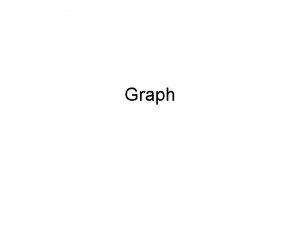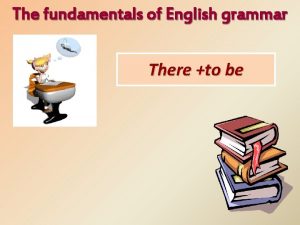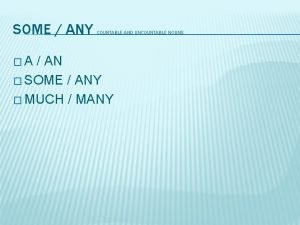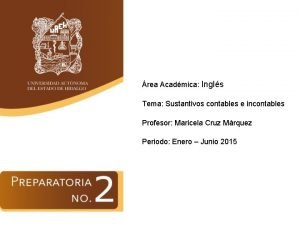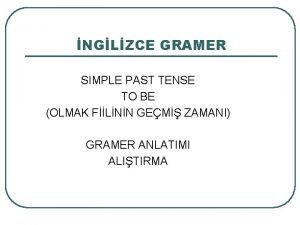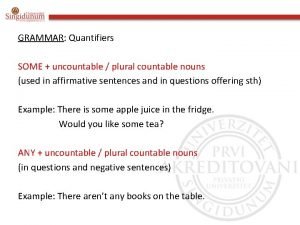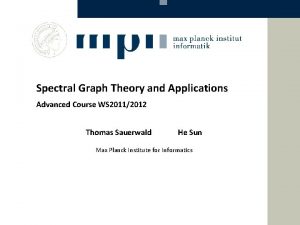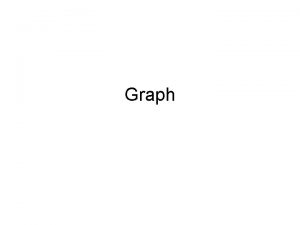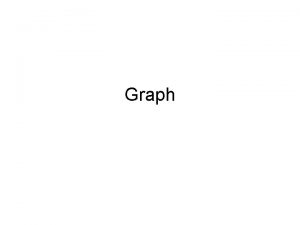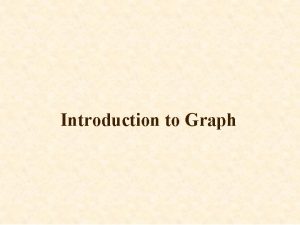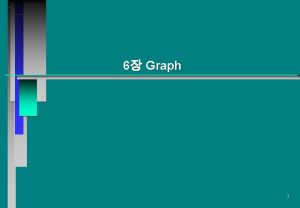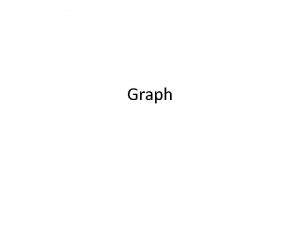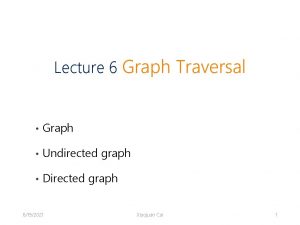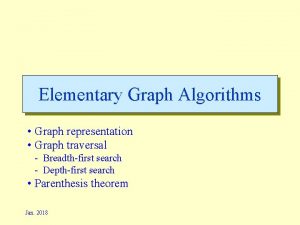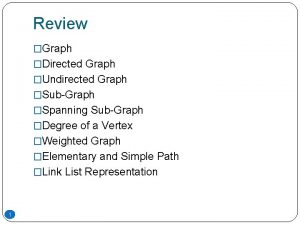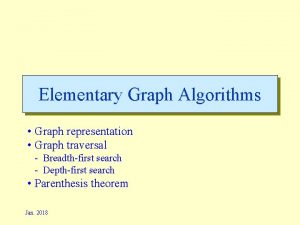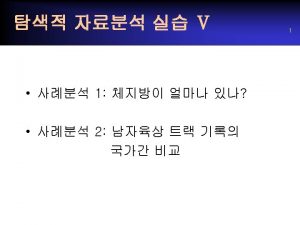Graph Outline Introduction to graph Is there a



























- Slides: 27

Graph

Outline • • Introduction to graph Is there a Eulerian trail, curcuit? Isomorphism and planarity Shortest path problem

Graph • G=(V, E), V is the set of vertices (nodes), E is the set of edges • Connected graph: where there is a path c between any pair of distinct nodes • A graph H is a subgraph of a G if all a nodes and edges in H are also nodes and edges in G, i. e. H=(V’, E’) where b • A connected component of a graph G is a connected subgraph H of G such that no other connected subgraph of G containing H exists. • Simple graph: no loop or parallel edges d e f V={a, b, c, d, e, f} E={(a, b), (a, c), (a, d), (c, d), (b, d), (e, f)}

Walks in graph walk no repeated edge no repeated vertices trail closed circuit use every edge Eulerian circuit path use every edge Eulerian trail nontrivial & only repeated node is first/last cycle use every node Hamiltonian cycle

Does a graph has an Eulerian trail ? C D A B • A Walk that go through all edges exactly once • Proposition: in any graph, if a vertex x has an odd degree, then x cannot be an interior vertex (i. e. , a vertex other than the starting or stopping point) in an Eulerian trail. – For interior vertex: vs…e 1 xe 2 … e 3 xe 4 … ve

Two theorems 1 3 2 4 5 7 6 8 9 10 • Graph G is called Eulerian if G has an Eulerian circuit (a closed walk that used every edge once and only once) • Let G be a connected graph. G is Eulerian if and only if every node in G has even degree.

Construct Eulerian circuit 1. Find any curcuit C in graph G: starting at a certain node, walking along unused edges until getting back to original node. 2. Form a graph G’ by removing from G all edges in C and all vertices that have no edges left. 3. G’ consists of graphs where every node has even degree; Use same process 1 to determine Eulerian circuits for G’ or its components. 4. Piece together circuit C, and Eulerian curcuits found for G’, and get an Eulerian curcuit for G. 1 3 2 4 5 7 6 8 9 10

Eulerian Trail • A connected graph G has an Eulerian trail if and only if G has exactly two nodes of odd degree. Moveover, the trail must begin and end at these two nodes – If G has exactly two nodes of odd degree, after adding an edge connecting these two nodes, G has Eulerian circuit (by previous theorem). By removing added edge from circuit, we get a trail starting/ending at two nodes. – If G has an Eulerian trail, it’s easy to see that the starting/ending nodes have odd degree, all other nodes have even degree.

Example 1 2 5 6 3 4

Outline • • Introduction to graph Is there a Eulerian trail, curcuit? Isomorphism and planarity Shortest path problem

Isomorphic Graphs • Formal Def. Graph G and H are called isomorphic if there is a one-to-one correspondence f, between the vertices in G to vertices in H, so that (u, v) is edge in G if and only if (f(u), f(v)) is edge in H. • One can rearrange G to get H 3 1 2 z 4 5 6 u y v x w

Are these two graphs isomorphic ? ƒ(a) = 1 ƒ(b) = 6 ƒ(c) = 8 ƒ(d) = 3 ƒ(g) = 5 ƒ(h) = 2 ƒ(i) = 4 ƒ(j) = 7

Checking isomorphism • Two graphs that are isomorphic to one another must have – – – Same number of nodes Same number of edges Same number of nodes of any given degree Same number of cycles of any given size • A pair of graphs satisfying above conditions are not necessarily isomorphic

Examples

Planar Graph • Often we want to draw graphs as clean as possible, as few crossings as possible Three utilities Three factories • Can we connect three factories to three utilities without one service crossing over the other ?

Definitions • A graph is called planar if it can be drawn on a plane so that no edges cross. Such a drawing is called an embedding. • Bipartite graph: the set of nodes can be partitioned into two sets so that every edge has one endpoint in one set, one endpoint in another set. • Complete bipartite graph, Km, n, is a bipartite graph with nodes S 1={a 1, …, am} and S 2={b 1, …, bn}, and every nodes in S 1 is connecting to every node in S 2. • Complete graph, Kn

Are these graphs planar? • K 4 • K 3, 2 • Kn, 2

Are these graphs planar? • K 5 • K 3, 3

Kuratowski’s Theorem • A graph G is planar if and only if contains no “copies” of K 3, 3 or K 5 as subgraphs • A graph is planar if and only if it does not contain a subgraph that is a subdivision of K 5 or K 3, 3. • A subdivision of a graph results from inserting vertices into edges

Euler’s Formula for planar graph • Def: for a planar graph G embedded in the plane, a face of the graph is a region of the plane created by the drawing. Note that we have one unbounded region. K 4 a b d b

Euler’s Formula for Planar Graph • Given an embedding of a graph, – Removing any edge from a cycle decrease by 1 the num. of faces – Every edge on a cycle borders exactly two faces – For acyclic graph, # of faces is 1 • For any connected planar graph G embedded in the plane with V vertices, E edges and F faces, it must be the case that V+F=E+2 (Euler’s formula)

Now why K 3, 3 is not planar ?

Outline • • Introduction to graph Is there a Eulerian trail, curcuit? Isomorphism and planarity Shortest path problem

Shortest Path Problem • Given a weighted graph and two vertices, u and v, find a path with minimum total weights between u and v • Applications: driving direction, flight reservation etc

Dijkstra’s Algorithm • Find the shortest paths from a single source to all other nodes • All weights are non-negative • Ideas: – Maintain a set S of vertices whose final shortest-path weights from source have been decided – Select from V-S a vertex with minimum shortest-path estimate, insert into S – Updating shortest-path estimates for nodes in V-S – Until S=V, all nodes have been determined

Idea of Dijkstra’s algorithm ∞ 2 b 7 6 ∞ 9 c 2 ∞ 11 8 f 2 3 0 a 1 1 5 6 d ∞ 53 4 e ∞ 5 S: nodes colored with red Label of vertex: the estimated or determined shortest-path weight Highlighted edges: used in the shortest paths

Practice Problem • Find shortest path from f to all other nodes 7 b c 2 2 3 a f 1 1 5 6 d 4 e
 Paragraph sandwich example
Paragraph sandwich example Graph outline
Graph outline Tema there is there are
Tema there is there are What part of speech is open
What part of speech is open There is there are negative form
There is there are negative form Countable and uncountable there is there are
Countable and uncountable there is there are There is there are
There is there are There is there are
There is there are There fifteen candies in that bag. now there only one left
There fifteen candies in that bag. now there only one left Adjetivos demonstrativos
Adjetivos demonstrativos A any some правило
A any some правило Some any contables e incontables
Some any contables e incontables There is and there
There is and there Ingilizce gramer zamanlar tablosu
Ingilizce gramer zamanlar tablosu Jeopardy countable and uncountable
Jeopardy countable and uncountable There is there are
There is there are There
There There's and there are
There's and there are Ecological succession
Ecological succession Intro paragraph outline
Intro paragraph outline Introduction paragraph outline
Introduction paragraph outline Introduction to software engineering course outline
Introduction to software engineering course outline And then there were none introduction
And then there were none introduction Line graph graph theory
Line graph graph theory Wait-for graph
Wait-for graph A brief introduction to spectral graph theory
A brief introduction to spectral graph theory Graphdbs
Graphdbs Introduction to graph databases
Introduction to graph databases

